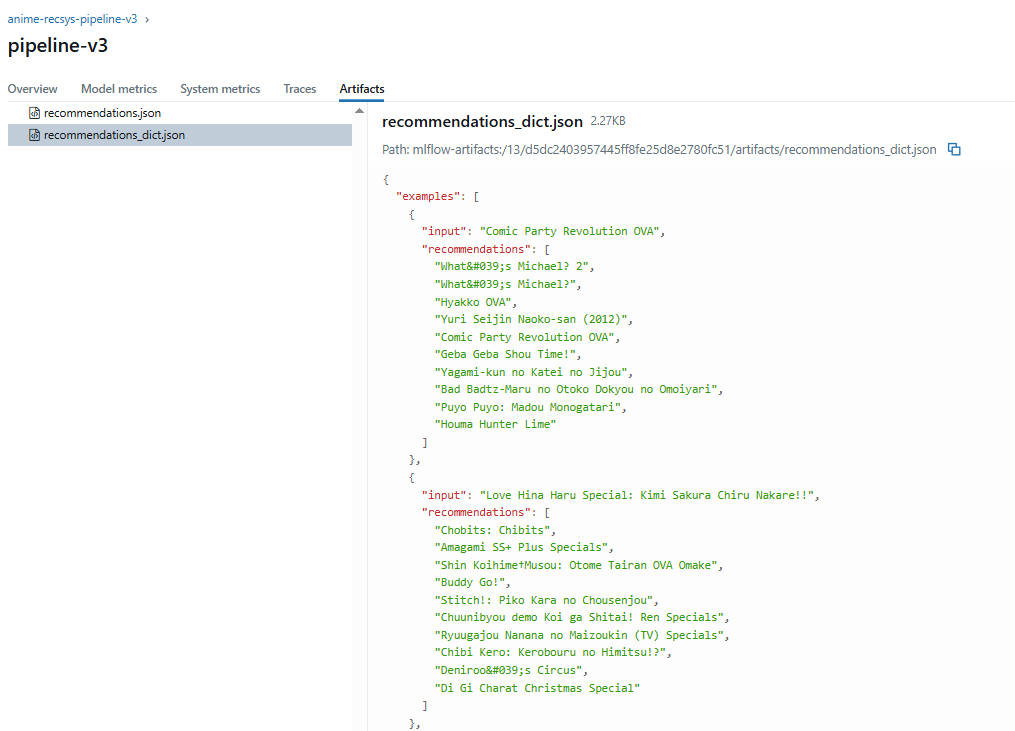到目前為止,我們已經有了不同模型:
問題:
👉 不同模型的輸出格式不一致,導致後續比較或 API 整合困難。
今天的目標:
統一推論輸出格式:
{
"input": "Naruto",
"recommendations": ["Bleach", "One Piece", ...]
}
把推薦範例存成 Artifacts,方便在 MLflow UI 查看與下載。
使用 MLflow 的 log_artifact() 與 log_dict() 完成紀錄。
我們新增一個 pipeline_v3.py。
/usr/mlflow/src/pipeline/pipeline_v3.py # 新版 Pipeline,統一推論格式 + 存 artifacts
/usr/mlflow/run_pipeline_v3.py # 執行入口
📂 路徑:/usr/mlflow/src/pipeline/pipeline_v3.py
import os
import json
import pandas as pd
import numpy as np
from sklearn.feature_extraction.text import TfidfVectorizer
from sklearn.metrics.pairwise import cosine_similarity
import mlflow
DATA_DIR = "/usr/mlflow/data"
class AnimePipelineV3:
def __init__(self, sample_size=1000):
self.sample_size = sample_size
def load_data(self):
"""載入動畫資料,只取部分樣本確保 3 分鐘內可跑完"""
anime = pd.read_csv(os.path.join(DATA_DIR, "anime_clean.csv"))
ratings_train = pd.read_csv(os.path.join(DATA_DIR, "ratings_train.csv"))
anime = anime.sample(self.sample_size, random_state=42).reset_index(drop=True)
return anime, ratings_train
def train_model(self, anime, max_features=1000, ngram_range=(1,1), min_df=2, use_type=True):
"""用 TF-IDF 訓練 item-based 模型,可以選擇是否加入 type 特徵"""
if use_type:
anime["features"] = anime["genre"].fillna("") + " " + anime["type"].fillna("")
else:
anime["features"] = anime["genre"].fillna("")
vectorizer = TfidfVectorizer(
stop_words="english",
max_features=max_features,
ngram_range=ngram_range,
min_df=min_df
)
tfidf = vectorizer.fit_transform(anime["features"])
sim_matrix = cosine_similarity(tfidf)
return sim_matrix
def predict(self, anime, sim_matrix, title, top_k=10):
"""統一推論格式"""
if title not in anime["name"].values:
return {"input": title, "recommendations": []}
idx = anime[anime["name"] == title].index[0]
sim_scores = list(enumerate(sim_matrix[idx]))
sim_scores = sorted(sim_scores, key=lambda x: x[1], reverse=True)
top_idx = [i for i, _ in sim_scores[1:top_k+1]]
recs = anime.iloc[top_idx]["name"].tolist()
return {"input": title, "recommendations": recs}
def evaluate_and_log(self, anime, sim_matrix, params):
"""測試 Precision@10,並存推論範例到 MLflow artifacts"""
def precision_at_k(recommended, relevant, k=10):
return len(set(recommended[:k]) & set(relevant)) / k
test_idx = np.random.choice(len(anime), 30, replace=False)
scores = []
examples = []
for idx in test_idx[:5]: # 只存 5 筆範例,避免 artifacts 太大
sim_scores = list(enumerate(sim_matrix[idx]))
sim_scores = sorted(sim_scores, key=lambda x: x[1], reverse=True)
top_idx = [i for i, _ in sim_scores[1:11]]
recommended = anime.iloc[top_idx]["name"].tolist()
relevant = anime[anime["genre"] == anime.iloc[idx]["genre"]]["name"].tolist()
if len(relevant) > 1:
scores.append(precision_at_k(recommended, relevant, k=10))
# 存成統一格式
examples.append({
"input": anime.iloc[idx]["name"],
"recommendations": recommended
})
avg_precision = np.mean(scores)
with mlflow.start_run(run_name="pipeline-v3") as run:
mlflow.log_params(params)
mlflow.log_metric("precision_at_10", avg_precision)
result_path = "recommendations.json"
with open(result_path, "w", encoding="utf-8") as f:
json.dump(examples, f, ensure_ascii=False, indent=2)
mlflow.log_artifact(result_path)
# mlflow.log_dict(),直接把 dict 存成 JSON
mlflow.log_dict({"examples": examples}, "recommendations_dict.json")
print("Run ID:", run.info.run_id)
print("Artifact URI:", run.info.artifact_uri)
return avg_precision
📂 路徑:/usr/mlflow/day15_run_pipeline_v3.py
import mlflow
from src.pipeline.pipeline_v3 import AnimePipelineV3
mlflow.set_tracking_uri("http://mlflow:5000")
mlflow.set_experiment("anime-recsys-pipeline-v3")
def main():
pipeline = AnimePipelineV3(sample_size=1000)
anime, ratings_train = pipeline.load_data()
params = {
"max_features": 1000,
"ngram_range": (1,1),
"min_df": 2,
"use_type": True
}
sim_matrix = pipeline.train_model(anime, **params)
score = pipeline.evaluate_and_log(anime, sim_matrix, params)
print(f"Pipeline V3 完成 ✅ Precision@10 = {score:.4f}")
if __name__ == "__main__":
main()
mlflow.log_artifact(path).json、.csv、.png。mlflow.log_dict(dict_obj, artifact_file)這兩個 API 適合存「推薦範例」、「推論結果」、「測試輸出」。
在容器中執行:
python day15_run_pipeline_v3.py
執行結果:
Console 會印出 Run ID、Artifact URI、Precision@10。
MLflow UI → Experiments → anime-recsys-pipeline-v3 → 點進 run → Artifacts,你會看到:
recommendations.json
recommendations_dict.json


AnimePipelineV3
│
├── load_data() → 抽樣資料
├── train_model() → TF-IDF 訓練
├── predict() → 統一輸出格式
└── evaluate_and_log()
├── log_params / log_metric
├── mlflow.log_artifact() → recommendations.json
└── mlflow.log_dict() → recommendations_dict.json
我們新增了 AnimePipelineV3,讓所有推薦輸出都有統一格式。
使用 MLflow 的 Artifacts 保存推論範例,方便比較不同 run 的輸出。
新增的 API:
mlflow.log_artifact() → 存本地檔案mlflow.log_dict() → 直接存 dict整個流程抽樣 1000 筆動畫 + 測試 30 筆,保證 3 分鐘內完成。
👉 下一步(Day 16),我們會嘗試 模型解釋 (SHAP/Feature Importance),並把解釋結果存到 MLflow。
